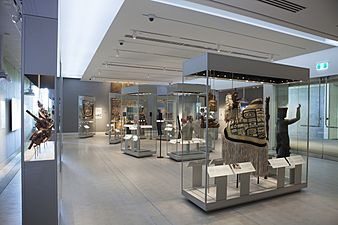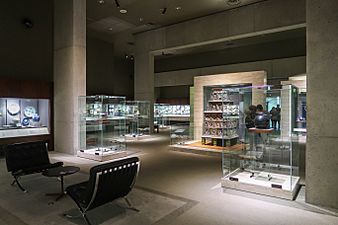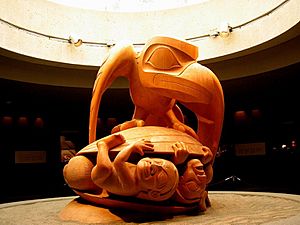Museum of Anthropology at UBC facts for kids
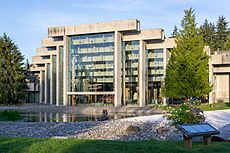
The Museum of Anthropology at UBC from the west
|
|
| Lua error in Module:Location_map at line 420: attempt to index field 'wikibase' (a nil value). | |
| Established | 1947 |
|---|---|
| Location | 6393 NW Marine Dr, Vancouver, British Columbia, Canada |
| Type | First Nations culture |
| Visitors | 189,661 (2016) |
The Museum of Anthropology (MOA) is a cool museum located at the University of British Columbia (UBC) in Vancouver, British Columbia, Canada. It shows amazing art and cultural items from all over the world. A big part of its collection focuses on the First Nations people from the Pacific Northwest.
MOA is not just a popular place for visitors. It's also a special place for learning and research. Students at UBC take classes here about art, history, and how museums work. The museum has nearly 50,000 cultural objects. It also holds about 535,000 archaeological items.
Contents
Discovering the Museum's History
The Museum of Anthropology started thanks to some important collections. In 1927, UBC got the Frank Burnett Collection. They also received two large house posts from the Musqueam people. These were donated by UBC's graduating class of 1927.
Other early items included totem poles and First Nations baskets. These were first shown in the basement of the UBC Main Library. The museum officially opened its doors in 1947. Harry Hawthorn was the first director. His wife, Audrey Hawthorn, was the first curator.
Building the New Museum
In 1971, the museum received money to build a new home. The Canadian government and UBC helped fund it. The new building opened in 1976. It was designed by a famous Canadian architect, Arthur Erickson.
Michael M. Ames became the new director in 1974. He led the museum until 1997. A huge collection of Northwest Coast First Nations art was given to the museum in 1975. This gift came from Walter and Marianne Koerner. It filled a large part of the new building.
Museum Leadership and Milestones
After Michael Ames, Ruth Phillips became director in 1997. Susan Rowley, a long-time curator, became director in 2021.
On March 9, 1999, Canada Post released a stamp to celebrate the museum. The stamp featured a famous sculpture. It was The Raven and the First Men by Bill Reid.
The museum closed for 18 months in 2022. This was for important safety upgrades. It reopened on June 13, 2024.
Exploring the Museum Building

The museum is located at 6393 NW Marine Dr. It's on the Point Grey campus of UBC. This area is not officially part of the City of Vancouver.
Arthur Erickson designed the building in 1976. He was inspired by the traditional post-and-beam style. This style is common in northern Northwest Coast First Nations buildings. The museum is mostly made of concrete. It even uses old World War II gun areas. The Bill Reid Raven sculpture sits on one of these former gun batteries.
Museum Upgrades and Additions
In 2006, the museum started a big project. They wanted to add a new research wing. This included new offices and labs. They also added a special research room. A recording studio and a large exhibition hall were built too. This new hall is called the Audain Gallery.
Other improvements included new Multiversity Galleries. A system called RRN was created. It connects Northwest Coast collections worldwide. The museum shop was moved and made bigger. A cafe and an outdoor area for events were also added. This project finished in January 2010.
In September 2010, a beautiful reflecting pool was added. It was placed at the front of the museum. This pool was part of Arthur Erickson's original design from 1976. It took almost 35 years for his vision to be completed.
In November 2020, the museum began a major safety project. They rebuilt the Great Hall. This was to make it stronger against earthquakes. This project helped protect the valuable collections. The museum reopened on June 13, 2024.
Discovering the Galleries
The O'Brian and Audain galleries are used for special, changing exhibitions.
Elspeth McConnell Gallery of Northwest Coast Masterworks
This gallery opened on June 22, 2017. It was once the Michael M. Ames Theatre. The new gallery was designed to be very special. It has outside sensors. These sensors change the indoor light. They match the light conditions outside. This makes the art look amazing.
The first exhibition here was called In a Different Light: Reflecting on Northwest Coast Art.
Koerner European Ceramics Gallery
The Koerner European Ceramics Gallery opened in 1990. It holds over 600 European ceramic pieces. These were collected by Walter Koerner. He gave them to the museum in 1987.
Multiversity Galleries
The Multiversity Galleries are home to more than 9,000 objects. These items come from all over the world. These galleries show many items from the museum's collection. These are items that would usually be kept in storage.
Exploring the Museum's Collection
The Museum of Anthropology has many large sculptures. It also has totem poles and other cultural artifacts. While MOA focuses on the First Nations of the Northwest Coast, its collection is global. It has nearly 50,000 cultural objects from every continent. The collection includes both old and new works.
Besides cultural items, MOA has about 535,000 archaeological pieces. These are managed by UBC's Laboratory of Archaeology. The museum also has a small section for European ceramic art. These were collected by the late Walter Koerner.
Famous Artworks and Sculptures
A famous sculpture is The Raven and the First Men by Bill Reid. It is made from yellow cedar. This sculpture was even on the Canadian twenty-dollar bill from 2004 to 2012. Other important works by Bill Reid include his Bear and Wasco (Sea Wolf) sculptures. He also made some gold jewellery. A model of the Haida dugout canoe he carved for Expo 86 is also there.
The museum has several large Musqueam artifacts. These are from the late 1800s and early 1900s. There are also many new works by Musqueam artists. These include pieces by Susan Point and Debra Sparrow. The museum's Great Hall has many parts of totem poles. These are from Haida and other First Nations villages. They come from along British Columbia's coast.
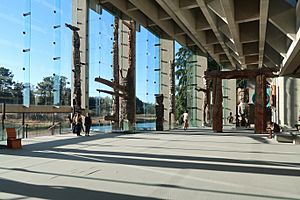
MOA also has a large collection from the South Pacific.
Textiles and Other Collections
There are about 6,000 textiles in the collection. About half of these are from Asia. The Cantonese opera costumes are especially notable. They are considered some of the best in the world. There are also textiles from the Northwest Coast, Oceania, Africa, and South America.
The Audrey & Harry Hawthorn Library and Archives is open to everyone. The archives have about 90,000 photographs. These photos show many cultures and historical events. The oldest photos are from the 1890s.
The African collection has about 2,800 items. Many early pieces came from missionaries and travelers. This collection includes masks and Yoruba thorn carvings. There are also over 100 Makonde figures from Tanzania. About 100 Asante gold weights are also part of it. Weaponry from South Africa and about 100 Egyptian funeral objects are also present.
About 40% of MOA's collection is from Asia. The Chinese collections include 1,000 to 1,500 pieces of Chinese ceramics. There are also Chinese calligraphy and paintings. A large collection of Japanese prints is also here. Buddhist art, Hindu art, textiles, and clothing are also featured.
Outdoor Exhibits
The Haida houses outside the museum are special. They were built under the direction of Bill Reid. He carved many of the totem poles around them with Doug Cranmer. The original totem pole on the big house was moved inside in 2000. This was to protect it from damage. A new pole, "Respect to Bill Reid Pole," replaced it. It was carved by Haida artist Jim Hart.
-
"Respect to Bill Reid pole," carved by Jim Hart at the Museum of Anthropology at UBC
-
Wuikinuxv house-front pole in the Great Hall
-
First Nations totem poles and Haida houses
-
Haisla canoe
-
"Sea Wolf" carved by Bill Reid
Educational Programs
The Museum of Anthropology helps with the Indigitization program. This program gives money and training. It helps Indigenous communities digitize their cultural items.
Every summer, MOA hosts the Native Youth Program (NYP). This is the longest-running training program for Indigenous high school students in British Columbia. It offers summer jobs and training. Six Indigenous high school students and two UBC students take part. MOA and the First Nation House of Learning at UBC organize this program together.
Museum Connections
The museum is connected to several important groups. These include the Canadian Heritage Information Network. It is also linked with the Canadian Museums Association. The museum is also part of the Virtual Museum of Canada.




